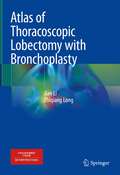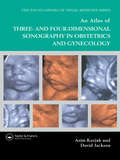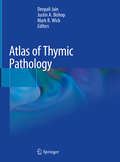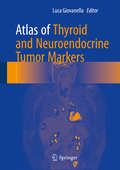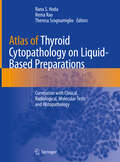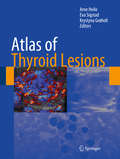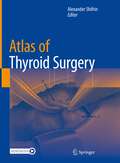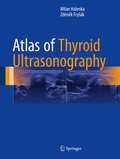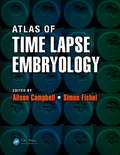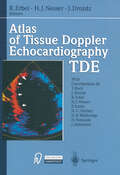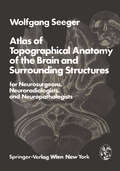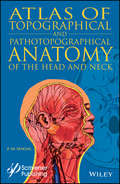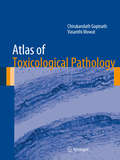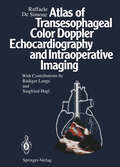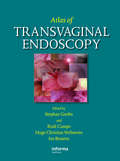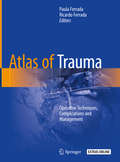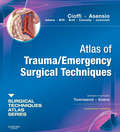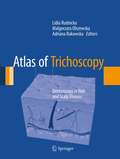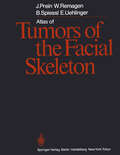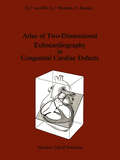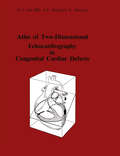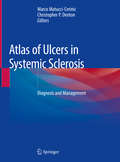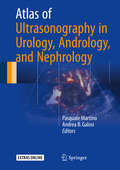- Table View
- List View
Atlas of Thoracoscopic Lobectomy with Bronchoplasty
by Jian Li Zhiqiang LongThis book introduces techniques and methods of the lymphadenectomy and the angioplasty under thoracoscope. It also presents the latest 2 cm uniportal lobectomy, which represents the highest level of thoracoscopic lung surgery technique. Compared to traditional thoracoscopic surgery, the survival and quality of postoperative life of patients undergoing lung cancer surgery have been greatly improved. This book provides a brand-new vision for thoracic surgeons to understand and learn the latest and most advanced development status and direction of modern minimally invasive techniques in thoracic surgery. The video screenshots fully reflect the real process of the operation and unique surgical methods. Thoracic surgeons will benefit from this book and improve the level of minimally invasive techniques in thoracic surgery.
An Atlas of Three- and Four-Dimensional Sonography in Obstetrics and Gynecology
by David JacksonAs the use of three-dimensional ultrasound in clinical practice increases, the need for a reference covering this and other emerging technologies also increases. The book presents three-dimensional ultrasound images in full colour accompanied by extensive captions and expert textual commentary. It provides authoritative coverage of the latest devel
An Atlas of Three- and Four-Dimensional Sonography in Obstetrics and Gynecology
by David Jackson Asim KurjakAs the use of three-dimensional ultrasound in clinical practice increases, the need for a reference covering this and other emerging technologies also increases. The book presents three-dimensional ultrasound images in full colour accompanied by extensive captions and expert textual commentary. It provides authoritative coverage of the latest devel
Atlas of Thymic Pathology
by Mark R. Wick Deepali Jain Justin A. BishopThis book reviews normal thymic structure and covers the histomorphology of benign and malignant tumors and rare lesions of the thymus, with detailed descriptions of over 300 full color photomicrographs accompanied by relevant clinical and radiology photographs and anatomical drawings. It includes chapters on the surgical pathology and cytology of thymic lesions (which is rarely described in the available literature), and all grades and stages of the most common thymic lesions. Written and edited by leading experts on pathology, the book highlights the expanded role of pathologists in patient care for thymic lesions. It will help students to understand thymic cytology and surgical pathology in detail and enable them to answer questions on thymic surgical resections and cytology cases in their pathology post-graduation examination. In addition, the book offers a comprehensive, richly illustrated guide to thymic pathology for clinicians, practicing pathologists, post-graduate residents and students alike.
Atlas of Thyroid and Neuroendocrine Tumor Markers
by Luca GiovanellaThis book highlights the increase in thyroid tumors and NET and demonstrates the growing importance of circulating markers in diagnosis as well as treatment and follow-up. Dramatic technical improvements have heightened the clinical impact of well-established, conventional biochemical markers. In addition, more recent genetic and molecular approaches have provided innovative molecular markers. In this context, effective communication between clinicians and laboratory physicians/scientists is essential in allowing all those involved to fully profit from these exciting advances. In this comprehensive, up-to-date book, authors from different laboratory and clinical areas link laboratory and clinical topics. Analytical problems such as interferences, false-negative and false-positive results are discussed in depth, and flow-charts offer insights into identifying and avoiding them. Illustrated clinical cases detail the clinical role and limitations of different tumor markers. Lastly, it explores health technology assessment and economic issues. This is a valuable resource for endocrinologists, oncologists, nuclear medicine physicians, scientists and technologists who want to keep abreast of the latest developments.
Atlas of Thyroid Cytopathology on Liquid-Based Preparations: Correlation with Clinical, Radiological, Molecular Tests and Histopathology
by Rana S. Hoda Rema Rao Theresa ScognamiglioThis illustrated volume serves as a handy guide to diagnostic fine needle aspiration (FNA) cytology of thyroid on liquid-based preparations (LBP). It is intended to be a ready resource to accurately diagnose thyroid lesions on LBP using key cytomorphologic features. Key cytologic differential diagnosis, gross, and histopathological correlations accompany the cytological findings. The Atlas of Thyroid Cytopathology on Liquid-Based Preparations is lavishly illustrated with color images of various thyroid diseases that should familiarize pathologists with the differences between conventional smears and LBP, and between the two commonly used LBPs. Authored by leaders in the field, this atlas provides clear, concise, and practical guidance pertaining to cytomorphology and the implications of thyroid FNA diagnoses for patient care in this era of precision medicine.
Atlas of Thyroid Lesions
by Arne Heilo Eva Sigstad Krystyna GrøholtAtlas of Thyroid Lesions provides a broad overview of the variety of lesions in the thyroid gland and their different characteristics and features, in the unique combination of ultrasound, cytologic and histologic appearance. Nodules in the thyroid gland are quite common. Studies estimate that more than 70% of the adult population in the United States has thyroid lesions when examined by ultrasound. More than 80% of thyroid nodules are benign. Too many benign nodules are surgically resected due to insufficient diagnostics, and too many malignant tumors do not get adequate primary surgical treatment. This book demonstrates how multidisciplinary approaches can increase the quality of the complex thyroid diagnoses and thereby secure correct treatment. This atlas presents: •Comprehensive description and overview of all thyroid lesions, tumor types, nodules and neck lymph node metastases •High quality ultrasound and pathology images •Easy to find images of anticipated tumor types •Didactic tools for how to improve diagnostic accuracy in the field
Atlas of Thyroid Surgery
by Alexander ShifrinThis surgical atlas illustrates the various successful thyroid surgery techniques of world-renowned surgeons. Some approaches presented include total thyroidectomy, right thyroid lobectomy, left thyroid lobectomy, minimally invasive approach to thyroidectomy, video-assisted approach to thyroidectomy, and endoscopic approaches, such as the transaxillary approach, bilateral axillo-breast approach (BABA), and trans-oral thyroid surgery (TOEVA). The Atlas is intended for a broader audience than publications for other procedures since thyroidectomy is among the most common neck procedures. The Atlas of Thyroid Surgery will help all surgeons caring for patients with thyroid disease minimize complications and perform successful thyroidectomy.
Atlas of Thyroid Ultrasonography
by Milan Halenka Zdeněk FryšákCombining high-quality ultrasound scans with clear and concise explanatory text, this atlas includes side-by-side depictions of various conditions of the thyroid both with and without indicative marking. Each ultrasound finding is displayed twice, six figures per page: The left-hand image is a native figure without marks; the right-hand image depicts marked findings. In this way, readers have the opportunity to see the native picture to assess it by themselves and then correct their opinion, if necessary. Five sections comprise this atlas, including the normal thyroid, diffuse thyroid lesions, both benign and malicious lesions (including various carcinomas), and rare findings. Including nearly 1500 ultrasound scans and covering the range of thyroid conditions, Atlas of Thyroid Ultrasonography will be a key reference for endocrinologists, radiologists, and primary care physicians, residents and fellows treating patients with thyroid problems.
Atlas of Time Lapse Embryology
by Alison Campbell Simon FishelUnlike conventional single daily observations, time lapse technology provides hundreds of images, which allows pinpointing of key events in the embryo's in vitro development as well as the detection of brief but significant critical changes. This information is beneficial in selecting the most viable embryos from a cohort and increases the chances
Atlas of Tissue Doppler Echocardiography — TDE
by Raimund Erbel, H. Joachim Nesser and Jaroslaw DrozdzThis is the first book to present an overview of the exciting new cardiac imaging technique of tissue Doppler echocardiography (TDE). In order to understand the background of this technique, it is necessary to compare the physical properties of blood, which reflects ultrasound poorly but moves with high velocity (up to 150 cm/s) with those of the myocar dium, which reflects ultrasound strongly but moves with low velocity (less than 10 cm/s). In tissue Doppler imaging, existing Doppler technology has been modified to bypass the high-pass filter and enhance calculation of low velocities, thus enabling selective visualization of the myocardium rather than of the blood. Because the color Doppler tissue images are super imposed on the conventional two-dimensional ultrasound images, this technique is known as TDE. Following a brief introduction, the history of ultrasound and Doppler imaging is presented. It is now about 150 years since the death of Christian Doppler, who described the "Doppler" effect, and more than 100 years since Pierre Curie discovered the piezoelectric effects of crystals. TDE was developed by Nobuo Yamazaki and Yoshitaka Mine at the Medi cal Engineering Laboratory, Toshiba Corporation, Tochigi, Japan. En gineers involved in the development of the technique have provided important technical information, which the reader will find an invaluable background to potential applications ofTDE.
Atlas of Topographical Anatomy of the Brain and Surrounding Structures for Neurosurgeons, Neuroradiologists, and Neuropathologists
by W. SeegerThe traditional education of the neurosurgeon and duce simultaneous contrast preparations of the ar the clinician working in related specialties is based teries and veins and thus obtain a complex photo on their presumed knowledge of the macroscopic graphic representation of the structures of the prep anatomy of the brain as traditionally taught. Most aration. neurosurgical textbooks, therefore, provide macro The manuscript and drawings were completed in the scopic views of sections of the operative site. The years 1974-1976 after almost two decades of neu literature that has accumulated in recent years on rosurgical work. The data worked out in the early the subject of microneurosurgical operations also stages (Chapter 1 in particular) were used by the follows this principle. author as the basis for teaching programmes at the For some years, however, the customary macro University of Giessen. Chapters 2-7, dealing with scopic representation of the anatomy of the brain the operative technical aspects, were produced after has been inadequate for the needs of the neurosur mid-1975 and used by the author as the basis for geon using refined modern operative techniques. microneurosurgical teaching of his colleagues at the Furthermore, despite their detailed presentation, University of Freiburg. stereotactic atlases are also insufficient for neuro My thanks are due to Doz. Dr. E.
Atlas of Topographical and Pathotopographical Anatomy of the Head and Neck
by Z. M. SeagalWritten by an experienced and well-respected physician and professor, this new volume, building on the previous volume, Ultrasonic Topographical and Pathotopographical Anatomy, also available from Wiley-Scrivener, presents the ultrasonic topographical and pathotopographical anatomy of the head and neck, offering further detail into these important areas for use by medical professionals. This atlas of topographic and pathotopographic human anatomy is a fundamental and practically important book designed for doctors of all specializations and students of medical schools. Here you can find almost everything that is connected with the topographic and pathotopographic human anatomy, including original graphs of logical structures of topographic anatomy and development of congenital abnormalities, topography of different areas in layers, pathotopography, computer and magnetic resonance imaging (MRI) of topographic and pathotopographic anatomy. Also you can find here new theoretical and practical sections of topographic anatomy developed by the author himself which are published for the first time. They are practically important for mastering the technique of operative interventions and denying possibility of iatrogenic complications during operations. This important new volume will be valuable to physicians, junior physicians, medical residents, lecturers in medicine, and medical students alike, either as a textbook or as a reference. It is a must-have for any physician’s library.
Atlas of Topographical and Pathotopographical Anatomy of the Head and Neck
by Z. M. SeagalWritten by an experienced and well-respected physician and professor, this new volume, building on the previous volume, Ultrasonic Topographical and Pathotopographical Anatomy, also available from Wiley-Scrivener, presents the ultrasonic topographical and pathotopographical anatomy of the head and neck, offering further detail into these important areas for use by medical professionals. This atlas of topographic and pathotopographic human anatomy is a fundamental and practically important book designed for doctors of all specializations and students of medical schools. Here you can find almost everything that is connected with the topographic and pathotopographic human anatomy, including original graphs of logical structures of topographic anatomy and development of congenital abnormalities, topography of different areas in layers, pathotopography, computer and magnetic resonance imaging (MRI) of topographic and pathotopographic anatomy. Also you can find here new theoretical and practical sections of topographic anatomy developed by the author himself which are published for the first time. They are practically important for mastering the technique of operative interventions and denying possibility of iatrogenic complications during operations. This important new volume will be valuable to physicians, junior physicians, medical residents, lecturers in medicine, and medical students alike, either as a textbook or as a reference. It is a must-have for any physician’s library.
Atlas of Toxicological Pathology
by Chirukandath Gopinath Vasanthi MowatThis atlas contains more than 700 illustrations that the authors have collected over the years as well as references and information pertaining to recently developed drug classes, including biologics. It is a useful bench reference for practicing pathologists and may also be used as a reference text by other experts from related fields. The atlas is organised into different chapters based on systemic pathology. Each chapter has illustrations with legends, and the atlas includes some rare examples of unique lesions found during toxicity studies over many years.
Atlas of Transesophageal Color Doppler Echocardiography and Intraoperative Imaging
by Raffaele DeSimoneDiese ideale Einführung in die TEE ist mit hervorragenden Originalaufnahmen ausgestattet. Zwei Disketten für Macintosh zeigen vier Filme, die auch auf der CD-ROM für Macintosh enthalten sind.
Atlas of Transvaginal Endoscopy
by Stephan Gordts Ivo Brosens Hugo C. Verhoeven Rudi CampoTransvaginal endoscopy of the female genital tract is a powerful new technique for the evaluation and management of pelvic disease. This highly illustrated book details the possibilities and advantages of these techniques, including transvaginal laparoscopy, salpingoscopy, patency testing, and vaginocervicohysteroscopy for the exploration of the ut
Atlas of Trauma: Operative Techniques, Complications and Management
by Paula Ferrada Ricardo FerradaThis atlas is the collaborative work of surgeons from Latin America and North America and describes techniques that can aid in the treatment of trauma patients. Trauma surgeons need to perform procedures efficiently and expeditiously for patients that are crashing. The surgeries and exposures are narrated by experts in the field, and include pitfalls and complications, as well as ways to avoid and treat them. Detailed illustrations add clarity to each procedure and help surgeons improve their technique when treating trauma patients. Atlas of Trauma provides a visual aid to the trauma surgeon and acts as a great asset for the training of these specialists.
Atlas of Trauma/ Emergency Surgical Techniques E-Book: A Volume in the Surgical Techniques Atlas Series
by William Cioffi Juan A. AsensioAtlas of Trauma/Emergency Surgical Techniques, a title in the Surgical Techniques Atlas Series, presents state-of-the-art updates on the full range of trauma and emergency surgical techniques performed today. Drs. Cioffi and Asensio, along with numerous other internationally recognized general surgeons, offer you step-by-step advice along with full-color illustrations and photographs to help you expand your repertoire and hone your clinical skills.Easily review normal anatomy and visualize the step-by-step progression of each emergency surgery procedure thanks to more than 330 detailed anatomic line drawings and clinical photographs.Avoid complications with pearls and pitfalls from the authors for every surgical technique.Master the key variations and nuances for a full range of emergency techniques. A highly formatted approach provides step-by-step instructions with bulleted "how-to" guidance for each procedure.
Atlas of Trichoscopy: Dermoscopy in Hair and Scalp Disease
by Lidia Rudnicka, Malgorzata Olszewska and Adriana RakowskaThe aim of this atlas is to provide detailed and comprehensive, easy-to-use information, sufficient to perform trichoscopy in clinical practice. From basics to advanced knowledge, everything in one book. In this sense it is rather an “illustrated textbook” than solely an atlas. It includes evidence based information, acknowledged algorithms, which help easy diagnosis and “take home messages”, which aid memorizing specific features of diverse diseases. The atlas consists of two major parts. In the first part the authors describe structures and patterns seen in trichoscopy. The second part consists of detailed description of characteristic trichoscopy features of diverse diseases of hair and scalp. Consecutive chapters illustrate genetic hair disorders, acquired hair loss and scalp diseases.
Atlas of Tumors of the Facial Skeleton: Odontogenic and Nonodontogenic Tumors
by Joachim Prein Wolfgang Remagen Bernd Spiessl Erwin UehlingerThe rare occurrence of tumors of the facial skeleton, whether of dental origin (odontogenic) or arising from bone (osteogenic), makes it impossible for a single observer to appreciate fully the epi demiologic and clinical behavior of these lesions, even if he controls the case material of a large institution. The systematic cooperation of many scientists is necessary in order to compile a meaningful body of information and make that information accessible for study. On the initiative of one of the authors (B.S.), the German-Austrian Swiss Association for the Study of Tumors of the Face and Jaws (DOSAK) resolved in 1971 to establish a special registry for tumors of the facial skeleton, including odontogenic lesions. This registry has been integrated into the bone tumor registry at the Swiss Asso ciation for Pathology in the Department of Pathology of the Uni versity of Basel. In 1974 DOSAK sponsored a symposium on odontogenic and os teogenic tumors of the jaws, at which illustrative cases were pre sented and discussed. These discussions revealed the problematic nature of these tumors and prompted a number of reclassifications, including some changes from benign to malignant and vice versa. It was found that radical and in some cases mutilating operations would not have been justified on the basis of the new classification. The discussions also underscored the importance of considering all factors - epidemiologic, clinical, radiologic and pathohistologi- when establishing a diagnosis.
Atlas of Two-Dimensional Echocardiography in Congenital Cardiac Defects
by G. J. Van MillIn a relatively short period of time two-dimensional echo cardiography has become the most important non-invasive diagnostic tool in the daily practice of a pediatric cardiologist who predominantly deals with congenital structural heart disease in neonates and infants. Consequently, one-dimensional M-mode echocardiography has lost most of its importance particularly in this field. Therefore, an atlas showing exclusively two-dimensional echocardiograms of the most common and some less frequently occurring malformations appeared to be a useful addition to the existing literature. The confinement to two dimensional imaging alone allowed an elaborate presentation of the various defects with more than 200 selected still frames and many additional explanatory drawings and diagrams. The material was collected from patients who were referred to the Department of Pediatric Cardiology of the Wilhelmina University Children's Hospital in Utrecht during a period of about 2 years. The two-dimensional echocardiographic findings were correlated with cardiac catheterization data and/or surgical procedures and/or post mortem investigations. The necessary echocardiographic equipment was aquired with financial aid from the Dutch Heart Foundation. We are indebted to Mrs. J. W. Wetselaar for her outstanding artwork. We also thank P. D. Woltema and F. J. van Waert for the photographic reproductions, Jacomine Bosma for preparing and type-setting the entire manuscript and Dr. N. Middleton for critically reading the English text. G. J. van Mill, M. D. A. J. Moulaert, M. D. E. Harinck, M. D. CONTENTS 1. Introduction and the normal heart Introduction The normal heart 2 2.
Atlas of Two-Dimensional Echocardiography in Congenital Cardiac Defects
by G.J. van Mill A. Moulaert E. HarinckIn a relatively short period of time two-dimensional echocardiography has become the most important non-invasive diagnostic tool in the daily practice of a pediatric cardiologist who predominantly deals with congenital structural heart disease in neonates and infants. Consequently, one-dimensional M-mode echocardiography has lost most of its importance particularly in this field. Therefore, an atlas showing exclusively two-dimensional echo cardiograms of the most common and some less frequently occurring malformations appeared to be a useful addition to the existing literature. The confinement to two dimensional imaging alone allowed an elaborate presentation of the various defects with more than 200 selected still frames and many additional explanatory drawings and diagrams. The material was collected from patients who were referred to the Department of Pediatric Cardiology of the Wilhelmina University Children's Hospital in Utrecht during a period of about 2 years. The two-dimensional echocardiographic findings were correlated with cardiac catheterization data and/or surgical procedures and/or post mortem investigations. The necessary echocardiographic equipment was aquired with financial aid from the Dutch Heart Foundation. We are indebted to Mrs. 1. W. Wetselaar for her outstanding artwork. We also thank P. D. Woltema and F. l. van Waert for the photographic reproductions, lacomine Bosma for preparing and type-setting the entire manuscript and Dr. N. Middleton for critically reading the English text. G. l. van Mill, M. D. A. l. Moulaert, M. D. E. Harinck, M. D. CONTENTS 1. Introduction and the normal heart 1 Introduction 1 T~~m~h~rt 2 2.
Atlas of Ulcers in Systemic Sclerosis: Diagnosis And Management
by Marco Matucci-Cerinic Christopher P. DentonThis Atlas examines skin ulcers in patients affected by systemic sclerosis. Although they are not life threatening, digital ulcers cause enormous pain, impact function and quality of life, and can lead to serious local complications such as gangrene, osteomyelitis, and permanent tissue loss. Knowledge and understanding of these ulcers is pivotal in everyday practice in order to arrive at an accurate early diagnosis, a correct analysis of ulcer characteristics, and an appropriate direct and systematic treatment. To that end, this book describes all the major characteristics of skin ulcers in systematic sclerosis, including classification, evaluation, and categorization. Richly illustrated for practical use, Atlas of Ulcers in Systemic Sclerosis: Diagnosis and Management is an essential resource for physicians and related professionals, residents, and graduate students in rheumatology, dermatology, and angiology.
Atlas of Ultrasonography in Urology, Andrology, and Nephrology
by Pasquale Martino Andrea B. GalosiThis book provides the latest recommendations for ultrasound examination of the entire urogenital system, particularly in the male. The coverage encompasses the role of ultrasound in imaging of disorders of the kidneys, urinary tract, prostate, seminal vesicles, bladder, testes, and penis, including male infertility disorders. In addition, detailed consideration is given to intraoperative and interventional ultrasound and recently developed ultrasound techniques. Each chapter defines the purpose of and indications for ultrasound, identifies its benefits and limitations, specifies the technological standards for devices, outlines performance of the investigation, establishes the expected accuracy for differential diagnosis, and indicates the reporting method. Most of the recommendations are based on review of the literature, on previous recommendations, and on the opinions of the experts of the Imaging Working Group of the Italian Society of Urology (SIU) and the Italian Society of Ultrasound in Urology, Andrology, and Nephrology (SIEUN). The book will be of value for all physicians involved in the first-line evaluation of diseases of the renal/urinary system and male genital disorders.
